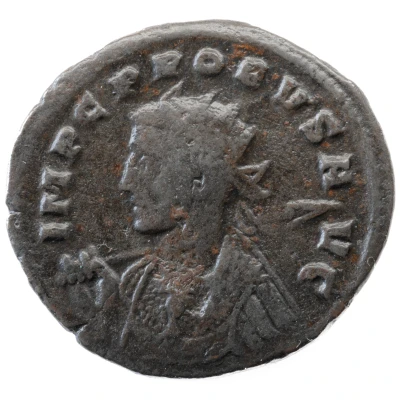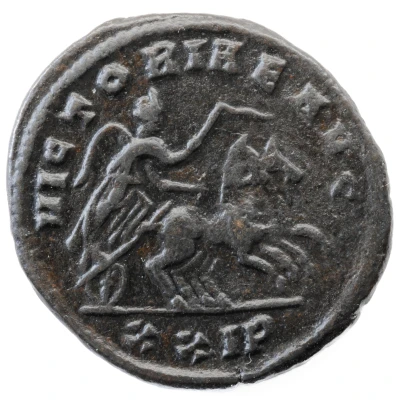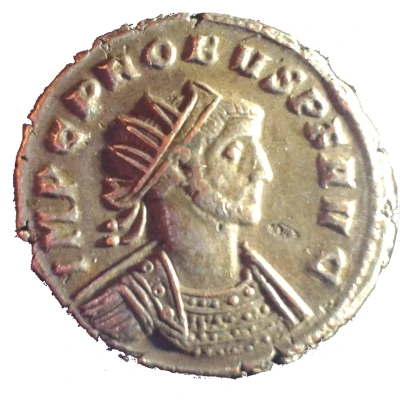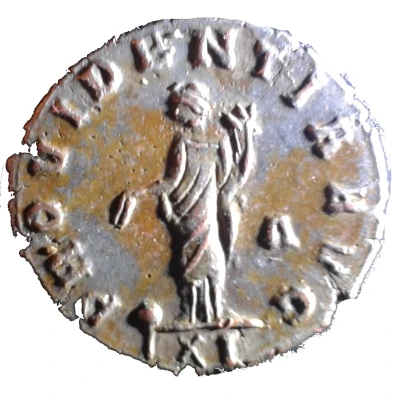


© PrimeME
Antoninianus - Probus cuirassed, left, spear; VICTORIAE AVG; Victory
| Silver | - | - |
| Issuer | Rome › Roman Empire (27 BC - 395 AD) |
|---|---|
| Emperor | Probus (Marcus Aurelius Probus) (276-282) |
| Type | Standard circulation coin |
| Years | 276-279 |
| Value | Antoninianus (1) |
| Currency | Antoninianus, Reform of Caracalla (AD 215 – 301) |
| Composition | Silver |
| Shape | Round (irregular) |
| Technique | Hammered |
| Orientation | Variable alignment ↺ |
| Demonetized | Yes |
| Updated | 2024-10-05 |
| Numista | N#375777 |
|---|---|
| Rarity index | 97% |
Reverse
Victory, winged, draped, in biga, galloping right or left.
Script: Latin
Lettering:
VICTORIAE AVG
-/-//XXIP
Translation:
Victoriae Augusti.
To the victory of the emperor (Augustus).
Comment
About RIC 797The original RIC text mentions 4 different variations/different bust types (bust types according to Pierre Bastiens grouping of bust types) and there are also two variants known:
[1] radiate, cuirassed, right (bust type B), Numista ;
[2] helmeted, radiate, cuirassed, left, holding spear in right hand and shield in left hand (bust type E1) (Alföldi 089.003), Numista ;
[3] radiate, wearing imperial mantle, left, holding scepter surmounted by eagle in right hand (bust type H2) (Probuscoins.fr #3331 and #4161) (Alföldi 089.001-002), Numista ;
[4] radiate, cuirassed, left, holding spear in right hand and shield in left hand (bust type F) (Alföldi 089.002u), Numista ;
[5] [var] radiate, cuirassed, left, holding spear in right hand (bust type F5), (this coin);
[6] [var] radiate, cuirassed, left (bust type B2) (example: Probuscoins.fr #91).
Only the 2nd, 3rd and 4th variation are also listed by Alföldi (Andreas Alföldi, Vorarbeiten zu einem Corpus der in Siscia geprägten römischen Kaisermünzen. Heft V. Verzeichnis der Antoniniane des Kaisers Probus, Budapest, 1939, 88).
About this variant of RIC 797
This variant with F5 bust on the obverse was minted by the 1st officina (exergue mark XXIP) of Siscia. RIC 797 does not list exergue mark XXIP and does not list bust type F5. Alföldi does not list bust type F5 either in connection to this coin type (nr. 089).
The reverse depicts Victory on a biga (a two-horse chariot). The biga is also present in:
- RIC 795: IMP C M AVR PROBVS P F AVG; bust F and H2;
- RIC 796: IMP C PROBVS P F AVG; bust F, H2 and a non-existing H2 variant with spear instead of scepter, see probvs.net on busts, bottom of the page;
- RIC 798: IMP C M AVR PROBVS P AVG; bust H2.
All these RIC-references have other obverse legends then this variant. None of these RIC-references lists bust type F5. Only RIC 798 lists exergue mark XXIP but, as mentioned, only lists bust type H2.
Therefore RIC 797 is the most corresponding RIC-reference because of the correct obverse and reverse legend and the listing of the somewhat similar bust type F1.
Another example of this coin variant can be found on: Probuscoins.fr #1618.
The emission/year
Probuscoins.fr and Probvs.net list RIC 795, RIC 796, RIC 797 (only on Probuscoins.fr) and RIC 798 as part of the 4th emission of Siscia (year 277), it seems with reference to Karl Pink, Der Aufbau der römischen Münzprägung in der Kaiserzeit VI/I, Wien, 1949. However, Pink does not mention the biga (two-horse chariot) for Siscia at all. He does mention the quadriga (four-horse chariot), with VICTORIAE AVG. According to Pink, the way the exergue marks in these RIC entries are depicted (for example 'XXIP' for the 1st officina) is common for the 4th emission, but also in the 5th (year 278) and 6th emission (year 279). Therefore, it seems also possible that RIC 797 was part of the 5th or 6th emission, which is then also true for RIC 795, RIC 796 and RIC 798.
Interesting fact
The Antoninianus - Probus coin was part of a series of coins issued during the reign of Emperor Probus (276-282 AD) to celebrate the Roman Empire's victory over the Goths. The coin's design features a cuirassed bust of Probus on the obverse (front side) and a depiction of Victory holding a spear and a shield on the reverse (back side). The coin was made of silver, which was a valuable and prestigious metal at the time. This coin is interesting because it highlights the importance of military victories in Roman culture and the use of coinage as a means of propaganda to promote the Roman Empire's power and influence. The coin's design also showcases the artistic skills of Roman engravers and the attention to detail that went into creating these coins.

